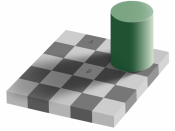How Optical Illusions Work Many of the visual illusions are characterized by misperception of size. An example of two of the better known size illusions are the Muller-Lyer illusion(see display)and the Ponzo illusion(see display) . In each one, a part of the figure appears larger than the other, even though they are both the same size. Almost everyone experiences these size illusions and always in the same way. For over a century, psychologists have been thrilled by these illusions and have focused a lot of research on testing various theories concerning their origins The most popular theory of size illusions attributes errors in perceived size to the operation of monocular cues. It?s called the ?depth theory.? Consider the Muller-Lyer illusion, according to the ?depth theory,? the arrowheads on the ends of the horizontal lines can be seen as angles formed by two intersecting surfaces. The horizontal line represents the point of intersection, or the corner formed by two surfaces.
When the arrowheads point outward, the two surfaces are seen as slanted towards you; when they point inward, the surfaces are seen as going away from you. According to the ?depth theory,? because of the perspective cues supplied by the arrowheads, the receding corner appears farther away than the approaching corner. At the same time, the retinal images of the two corners are identical in size. There is only one way objects at different distances can cast images of equal size: the farther object is the larger it must be. The ?depth theory? attributes size illusion to errors in perceived distance. This theory is based on the observation that perceived size remains constant no matter differences in distance from the viewer and, in doing so, changes in the size of the retinal image cast. In other words, perceived size...


